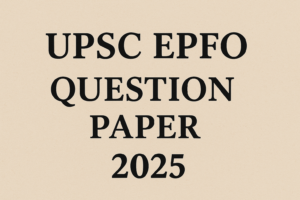Q.4 How are climate change and the sea level rise affecting the very existence of many island nations? Discuss with examples. (10 Marks, 150 words)
| Approach |
| Begin by introducing the existential risks posed by climate change and sea-level rise to island nations with supporting data. Discuss ecological impacts (flooding, coral bleaching, water insecurity, biodiversity loss) and socio-economic impacts (migration, tourism decline, economic vulnerability, health risks) with examples. Conclude with the urgency of global climate action, adaptation strategies, and international cooperation to safeguard island nations. |
Climate change–induced sea-level rise has emerged as an existential threat to many island nations, particularly the Small Island Developing States (SIDS). According to the IPCC, global sea levels have risen about 20 cm since 1900 and may rise by up to 1.1 m by 2100, endangering low-lying nations like Maldives, Tuvalu, and Kiribati.
Impact of Climate Change and Sea-level Rise on Island Nations
Ecological Impact
- Flooding and Innundation: Inundation of coastal areas, salinization of freshwater, and habitat loss.
-
- Eg: Maldives and Tuvalu face existential threats due to rising sea levels.
- Extreme Weather Events: Intensified hurricanes, cyclones, and floods disrupt economies and livelihoods.
- Eg: Hurricane Dorian (2019) devastated the Bahamas, causing over $3 billion in damages.
- Coral Reef Degradation: Coral bleaching due to ocean warming and acidification affects marine biodiversity and fisheries.
- Eg: Coral bleaching in Fiji and the Marshall Islands has reduced fish stocks, impacting food security.
- Water Insecurity: Saltwater intrusion contaminates freshwater sources.
- Eg: Kiribati and the Marshall Islands are facing severe drinking water shortages.
- Biodiversity Loss: Endemic and migratory species lose habitat due to climate shifts and human displacement.
- Eg: Sea turtles in Caribbean islands are affected by temperature-altered sex ratios during incubation.
Socio-Economic impacts
- Threats to Human Habitation and Livelihoods: Entire communities may be forced to migrate (“climate refugees”), risking cultural loss.
- Eg: Kiribati has begun planning offshore resettlement in Fiji.
-
- Threats to Tourism and Livelihoods: Beach erosion, coral death, and infrastructure loss harm tourism-based economies.
- Eg: Barbados is facing reduced tourism revenues due to storm damage and environmental degradation.
- Economic Vulnerability: SIDS often have small, undiversified economies highly exposed to climate shocks.
- Eg: Infrastructure damage from storms diverts national budgets away from development.
- Threats to Tourism and Livelihoods: Beach erosion, coral death, and infrastructure loss harm tourism-based economies.
- Health Risks: Rising temperatures increase vector-borne diseases (e.g., dengue, chikungunya), and deteriorating water quality causes diarrheal diseases.
The existential threat faced by island nations highlights the need for urgent, equitable climate action. Prioritizing nature-based solutions, early warning systems, and island-specific adaptation plans should be central to global and regional partnerships.

 UPSC EPFO Answer Key 2025 Out (Unofficia...
UPSC EPFO Answer Key 2025 Out (Unofficia...
 UPSC EPFO Question Paper 2025 PDF Downlo...
UPSC EPFO Question Paper 2025 PDF Downlo...
 UPSC EPFO Admit Card 2025 Out @ upsc.gov...
UPSC EPFO Admit Card 2025 Out @ upsc.gov...

























